Day 3 of Thanksgiving Real Food Remix Week. So far we’ve looked at a couple appetizer ideas to serve pre-main course: pumpkin hummus and a caramelized leek & bacon dip.
Today, and over the weekend, we’re going to start looking at real food remixed main course side dishes… finally finishing up on Monday with dessert! (I want to to give you a few days to get any ingredients you need before Thanksgiving Thursday 🙂 )
First up of the side dishes, a cauli- “mashed potato” & gravy recipe made with…you guessed it, cauliflower! I was going to do plain ol’ mashed potatoes, but there’s countless recipes for it with a simple google search, most all with a few basic ingredients: potato, butter, salt and mash it up.
This recipe is a little more unique, tastes awesome, and is super low carbohydrate/starch comparatively to regular mashed potatoes. It’s also gluten free and dairy free.
Ingredients
1 large head cauliflower
1/2 medium onion, sliced
8 cloves garlic, sliced
2 tablespoons coconut milk
2 tablespoons ghee
1 tablespoon coconut oil
1 teaspoon pink salt
1 teaspoon garlic pepper
Optional: paprika to taste and chopped chives to serve.
Directions
1. Add your coconut oil and onion to a pan on low-medium heat and let them cook for about 10-15 minutes, or until soft and translucent
1a. Simultaneously, add about 2 cups of water to a pot with a steaming basket and turn your burner to high (I use my pasta pot which has everything all in one)
2. Pull apart or slice your cauliflower into florets and add to your steaming basket. You can use the stems too.
3. Steam cauliflower for about 8-10 minutes, or until it gets soft.
4. Once cauliflower and onion are done, let cool a bit (you don’t want it scorching hot) add them with all your other ingredients to a food processor or blender
5. Process everything until it turns into a smooth, mashed potato consistency (no chunks of anything).
6. Season with salt & pepper taste.
7. When you’re ready to serve, simply add to a pot to warm up on the stove and finally serve with chopped chives and gravy.
Looking for the gravy recipe? Keep scrolling down, it’s at the bottom.
Looking for some startling facts about the the mashed potatoes and gravy we find in the grocery store? read just below..
Of course, if you use a traditional mashed potato recipe over this cauli-fied one, that is fine. You won’t hurt my feelings! But I’m hoping you’re not going for the boxed stuff we find located down the main aisles in the grocery store, right?
For this real food remix post I wanted to compare this Paleo cauli-mashed potato recipe or a traditional basic mashed potato recipe (all real, whole foods) with the boxed “mashed potatoes” (and I stress those quotation marks!) they put on our super market shelves…and worse, allow in our food supply and to the general public.
There are a number of boxed mashed potatoes brands, all with the same similar ingredients (I hesitate even calling these ingredients), but let’s take a look at the ones that are in this food-like product below:
First off, basic mashed potatoes should be a few basic ingredients: potato, butter, salt & pepper. They shouldn’t look like anything like this alien-like ingredient label above. This is not real food. This is a food-like product made for prolonged shelf life, utilizing the cheapest ingredients for higher profit margins, and formulated, marketed and labeled so the consumer comes back for more as a repeat buyer. It is not designed in ANY way for your health, vitality or athletic performance. In fact, ingredients in these type of processed foods are detrimental to all three.
Let’s take a look at a few of the ingredients highlighted (i’ll cover a few in this specific post.. If I covered all of them we’d be here all day reading a book…seriously. I site a few books below that go into great detail on a lot of this junk however):
Vegetable shortening powder (consisting of partially hydrogenated soybean oil, lactose, sodium caseinate, & dipotassium phosphate)
– Partially hydrogenated soy bean oil: likely a GMO source being that over 90% of the soy in the U.S. is genetically modified, and judging by this label above, CLEARLY they have your health in mind, right? *face palm*. Many of us have heard of hydrogenation, it’s a method food industry uses to stabilize liquid vegetable oil so they are solid (think margarine). When we partially hydrogenate fats, they can produce trans fatty acids as a result. Trans fats have been shown to clog arteries, cause type 2 diabetes, and many other health problems.
– Sodium caseinate is a hidden name for MSG, or Monosodium Glutamate, an excitotoxin that causes neurotoxicity (toxic to the nerves) and brain cell death (literally kills brain cells). Two great books I have in my library that cover MSG in great detail are Excitotoxins by Dr. Russell Blaylock, and The Crazy Makers by Carol Simontacchi. Both books I highly recommend.
Other ingredients:
– Maltodextrin: this is a cheap filler used by food industry and is derived from corn (and likely GMO being roughly 90% of corn is GMO in the US). For all you athletes, weekend warriors and workout buffs, you’ll also likely find this in your protein powders and meal replacement shakes.
– Natural & Artificial flavor: Most of us know artificial flavor is just that, an artificial, lab-created chemical. Natural flavor is the one that I want to touch on because it confuses the consumer. Most people see “natural” and associate that with good. Nothing can be further from the truth with Natural Flavors when you see it on the food label. When you see this word, it can be one of hundreds of items that are on the GRAS, or Generally Recognized As Safe list. That means this one word “natural flavor” we see could be 1 ingredient, but it could also be 10 ingredients, or 100 ingredients. We wouldn’t know. But Jon, they’re generally recognized as safe? Well, aspartame is on this list, and it’s not so safe as we know that it’s a neurotoxin, amongst a whole host of other problems it contributes to (see this extensive list!). The GRAS list, simply, is not designed with your health in mind.
– BHT & BHA: butylated hydroxytoluene & butylated hydroxyanisole are common preservatives found in foods in the U.S., as well as common tongue twisters sure to give your mouth a workout. Noticed I said “in the U.S.”. BHT and BHA are in fact banned in nearly every country except the U.S. because they have been shown to cause cancer in studies, amongst other things.
In the image below of the canned gravy, again, all are junk, but I want to point out how food industry can add excess amounts of one ingredient, camouflaged as different ingredients.
Take a look at monosodium glutamate, autolyzed yeast extract, dextrose, maltodextrin and natural flavor. Five different ingredients, right? Actually, all can be forms of MSG. The FDA does not regulate these words (in terms of amount of MSG in a product), so sort of like natural flavors, we find an ingredient hidden behind different words. Here is a list of common ingredients found on labels that can be hiding MSG. Here’s another list showing percentage breakdowns of some of the highest amounts of MSG.
My recommend is to avoid as much as possible all ingredients that are highlighted not only on these food labels above and below, but any food label you find that lists them. If you’re a calorie counter where your first look is at the proteins, carbs and fats in an item… start getting into the habit of looking at these kind of ingredients as well (your body will thank you). We can just look at the potatoes above: 2/3 cup serving with 1.5 grams of fat, 21 carbs, 2 grams fiber and only 110 calories. On the “macros” surface, hey not so bad, right? But behind that surface we take a look at what it’s made up of and it’s absolute garbage for your body and cells.
Gravy Recipe
If you’re making this for Thanksgiving, this is great to make a day ahead of time so that you’re not trying to fuss with making it day of, as well as letting the juices and spices all marriage together overnight for an even more awesome flavor!
Step 1 ingredients: Making your chicken or turkey legs
5 organic chicken legs or two organic turkey legs
3 tablespoons coconut oil
2 tablespoons organic ketchup
Small amount of pink salt and pepper to season poultry
½ cup chicken broth for deglazing pan
Directions:
On low heat, place coconut oil in large heavy skillet. Whisk in the ketchup and turn heat up to medium. Quickly place poultry into skillet and rub it around the ketchup/oil mixture, turning over with tongs to coat both sides. You need to do this quickly because once the ketchup/oil mixture heats up it will splatter and make it difficult to add the poultry. Brown the legs on both sides and remove to a baking dish. Deglaze pan with chicken broth and remove from heat.
Bake the poultry at 350 degrees Fahrenheit until cooked thru (approximately 30 minutes). Remove poultry from the baking dish and place on a plate to cool. Save the juices!! Once cool, refrigerate poultry for another meal.
Step 2 ingredients: Making your gravy after you have your chicken/turkey legs cooked (those juices!)
4 tablespoons ghee + 3 Tablespoons ghee (this 3 tablespoons should be at room temp as it will be used to thicken the gravy)
1 cup chopped yellow onions
½ teaspoon garlic pepper
2 tablespoons dried thyme
sea salt and pepper to taste
2 tablespoons potato flour*
Poultry juices from Step 1 + pan drippings that were deglazed in step 1, and chicken broth to make 2 cups (have a little more chicken broth on hand in case you prefer a thinner gravy)
*Kitchen notes: I’ve tried arrowroot and other “paleo” thickeners, but it’s not the same as the potato flour for gravy. I’m not a big stickler on potatoes being paleo or not (and we’re talking 2 tablespoons in the entire recipe), but historic records showed we ate them. It’s really not a matter of “it IS or ISN’T paleo” for all people, but as I always refer back to, is it right for your metabolic type and biochemical make up?
Directions:
In a large skillet, add the 4 tablespoons of ghee and onions and cook over medium low heat until the onions are well cooked and are slightly browned. This might take as long as 15 – 20 minutes. In the meantime, heat the poultry juices, deglazed pan juices and the chicken broth in a small saucepan. Add the garlic pepper and dried thyme to the broth. Keep broth on warm while making your potato flour paste (for thickening the gravy).
Potato Flour Paste: In a small bowl place the 3 tablespoons of room temperature ghee (softened). Add the 2 tablespoons of potato flour and with the back of a spoon incorporate both into a smooth paste.
Pour the warmed broth into a glass measuring cup (for ease in adding to thickened mixture below)
When onions are nicely browned, whisk in the potato flour paste. Immediately whisk in the heated broth, poured in a steady stream from glass measuring cup. Once desired thickness is achieved, remove from heat and add salt and pepper to taste. If gravy seems too thick to your liking, add chicken broth a little at a time until desired thickness is reached. Check for seasoning and it’s ready to serve.
Kitchen notes: If you want to make your gravy the day of Thanksgiving and use your main course turkey you make and the pan drippings from it, just eliminate most of Step 1 but you will need to deglaze your turkey pan drippings with ½ cup of chicken broth. Then proceed to Step 2.

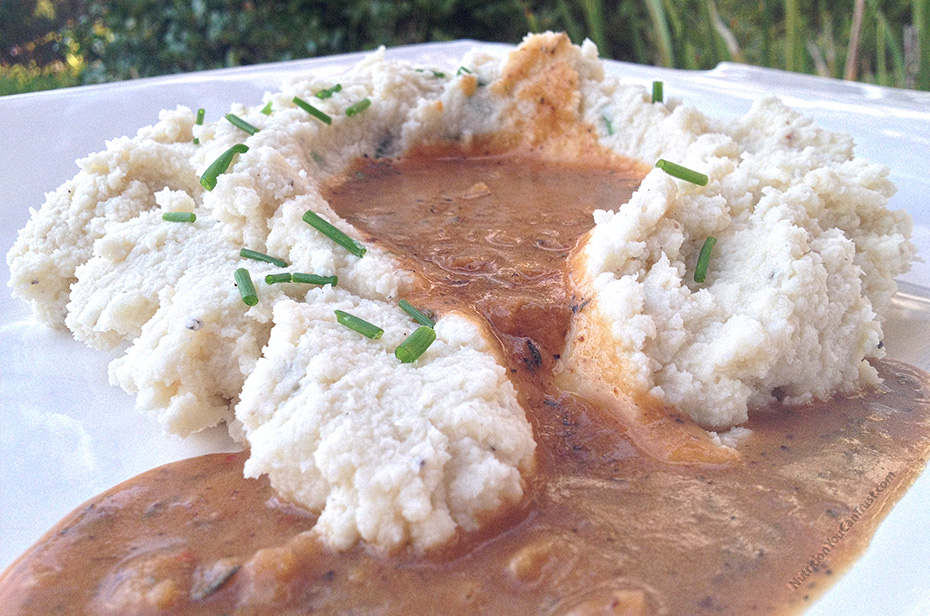









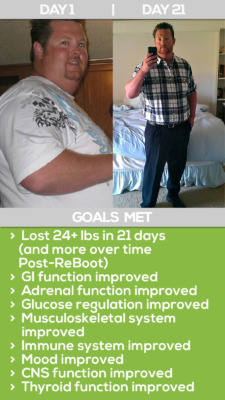




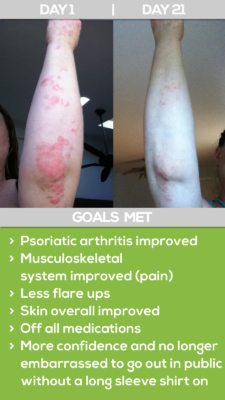



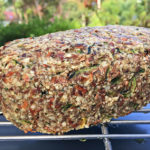


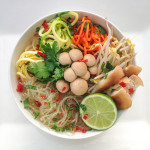
Yay! This is the one I have been waiting for. Looks fab! Thank you!
Awesome, enjoy Emily
it’s seriously pathetic they allow those kind of ingredients in food. Disguting to me.
I hear you my man, couldn’t agree more